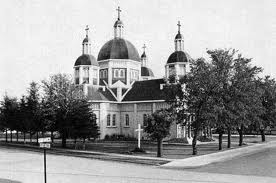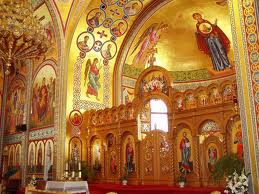|
The word Byzantine was given a pejorative connotation by some Western standards to signify a state of inferiority of both mind and spirit. The first vilification of the name came from the Carolingian officials when their King, Charlemagne, was refused by Constantinople the title of "Emperor of the Romans."
The Byzantine churches and monasteries of Athens are a quiet haven in the frenzied jungle of the more recently developed city. They link Athens with the part of history that once tried to exclude it. They are small oases where life still retains some of the old pattern and charm, a sanctuary in the great melting-pot of this modern capital.

The style of the Hagia Sophia or Church of Divine Wisdom, was to have a large dome in the middle of the structure. The dome has a unique form in that it rest on 4 massive pillars which are arranged in a square.
The dome remained the main focus of the Byzantine Church for the remainder of the empire. Metropoleos Square (church) is found near the new Metropolis, in the square of the same name. It is dedicated to Panayia Gorgoepikoos and Ayios Eleftherios. It was built at the end of the 12th century. Ancient and Byzantine reliefs were used in its construction. On the church's facade, notice especially the Attic calendar of feasts on the ancient frieze, which comes from a monument of the 4th century.

Basil I (867-886), like many of his predecessors, built in the area of the Great Palace, two churches: the New Church and the Church of the Theotokos of the Pharos. These set a fashion in church building and decoration that was to exercise an influence for many centuries. Neither survives, but something is known of them from written descriptions, and it would seem that both were typical of what was to be the mid-Byzantine style.

Haiga Irene church was not dedicated to a saint, but to a concept: Peace. It would be more appropriate to call it Holy or Divine Peace rather than St. Irene. This was the name of the goddess of peace and she was depicted as a beautiful woman; the church was built on a previous temple to Venus, the goddess of beauty, an indication of a smooth transition from the old beliefs to the new faith. Its construction is attributed to Emperor Constantine, thus it is the oldest church of the city.
The Church of Byzantium played a major role in the development of Liturgical traditions that would spread throughout the Middle East. There are fourteen Churches that follow the Byzantine Liturgy, yet all have their own variations and history.
|

![]()


